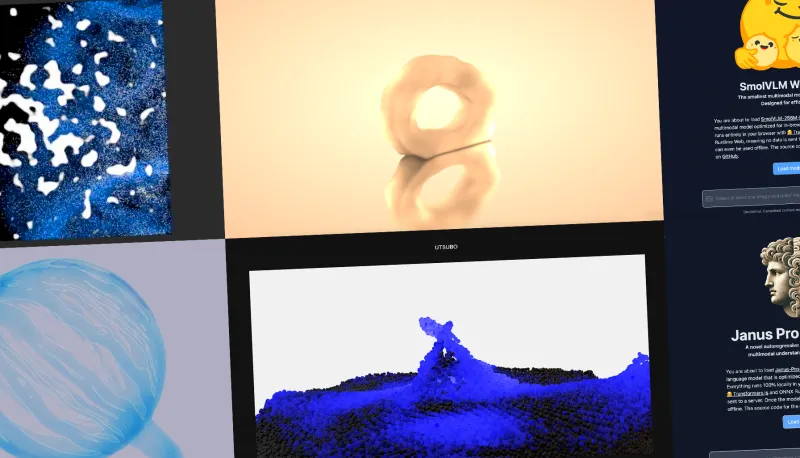Why WebGPU is the Future of Immersive Metaverse Experiences?
The Web-Based Metaverse Revolution: Unveiling How WebGPU will Shape the Future of Immersive Virtual Experiences and Redefines Online Interaction.
Last updated: January 10, 2024Understanding the Metaverse and Its Evolution in 2024
The Metaverse: Shifting Perspectives and Emerging Opportunities
In 2021, when Facebook rebranded as Meta, there was a surge of enthusiasm surrounding the Metaverse, sparking widespread interest and speculation about its future.
However, as we move into 2024, the initial hype has tempered, and some companies have grown skeptical about the practicality and profitability of the Metaverse. This shift in sentiment reflects the challenges and complexities involved in bringing these ambitious virtual worlds to fruition.
A Generation Growing up in the Metaverse
Despite this cooling of corporate interest, the Metaverse continues to hold significant promise, particularly among younger generations.
Gen Z and Millennials, having grown up in a world where digital interaction is the norm, are already engaging with Metaverse-like environments, often without realizing it. Their interaction ranges from immersive gaming worlds to social VR platforms, indicating a seamless integration of Metaverse concepts into their daily digital experiences.
The Economic Potential Amidst Scepticism
Businesses should not be quick to dismiss the Metaverse. While it presents its share of challenges, it also offers immense opportunities, especially considering its potential influence on future consumers and business leaders.
The Metaverse's projected economic impact remains substantial. Bloomberg Intelligence forecasts the Metaverse market to reach $800 billion by 2024. Additionally, the Analysis Group estimates that the global Metaverse economy could contribute 2.8% to global GDP, amounting to over $3 trillion within a decade. These figures underscore the importance of the Metaverse as an emerging economic force, despite the current skepticism.
However, the Metaverse is not without its challenges. Issues like accessibility, hardware requirements, and the quality of 3D environments have been points of contention, impacting the user experience and reach.

Current Challenges in the Metaverse
Overcoming Accessibility Barriers
The Metaverse has a lot of potential, but it's facing big challenges that stop more people from using it. One of the biggest problems is that it's not easy for everyone to get into. Many Metaverse platforms need you to download an app and have powerful or expensive computers, gaming consoles, or VR headsets to really enjoy them.
This makes it hard for a lot of people to join in because they need expensive equipment or have to go through complicated steps just to get started.
Performance and Quality Concerns
In addition to accessibility, the quality of 3D environments and overall performance remains a major concern. Presently, most Metaverse platforms struggle to render high-quality 3D graphics, particularly when it comes to accommodating a large number of characters in a shared space.
The usual cap of around 200 characters on screen significantly restricts the depth and realism of these environments. This limitation is particularly evident in scenarios like virtual concerts or seminars, where the ability to host a large, interactive audience is crucial for an immersive and enjoyable experience.
Web-Based Metaverse, the Solution to Accessibility and Performance Issues?
These limitations pave the way for the emergence of a web-based Metaverse. This concept aims to overcome the barriers of traditional Metaverse platforms by utilizing the universal accessibility of the web.
Envision a Metaverse that is easily reachable with just a click or a QR code scan, accessible from any device – from your smartphone and tablet to your VR headset. This universal accessibility eliminates the need for complex setups or expensive hardware, democratizing the entry into these virtual spaces for a wider range of users.
Such an approach not only simplifies access but also widens the potential user base, offering a more inclusive and engaging virtual experience.

The Promise of a Web-Based Metaverse
Ease of Access and Connectivity
The web-based Metaverse marks a significant shift in how we enter and interact with virtual spaces. Its main advantage is how easy it is to get into - there are no downloads or installations needed. You can just click on a link or scan a QR code, and you're in.
This simplicity is not just convenient for users, but it's also really important for Metaverse projects that are focused on marketing. In these cases, it's crucial to keep as many users as possible from dropping off.
The simpler it is for users to access these virtual spaces, the higher the chances of converting casual visitors into engaged participants or even loyal customers.
Moreover, this ease of access can lead to users spending more time in the Metaverse, exploring different aspects of the virtual world, and potentially making it a regular part of their digital life.
This sustained engagement is invaluable for brands and organizations looking to build a strong presence in the Metaverse.
Overcoming Technical Constraints
However, this approach does have its own set of challenges.
For a long time, WebGL was the main way to create 3D environments on the web.
But WebGL wasn't built for the latest GPU technology as it was designed back in 2011. This means that it can't take advantage of the latest hardware and software features, which limits what you can do with it.
At Utsubo, over the past few years, we've developed several web-based Metaverse projects such as Sougen and Konpi, using WebGL technology. Our experience with WebGL has allowed us to push the boundaries of 3D rendering capabilities in web browsers. For instance, in our Metaverse environments, we have successfully displayed up to 2000 different avatars on the same screen, along with high-quality 3D graphics and particle effects, all integrated into a gamified experience.
Nonetheless, achieving such results with WebGL has not been without its challenges. It's been a demanding and time-consuming process, often requiring us to make compromises to meet client requirements.
The limitations of WebGL mean that while we can create impressive visuals and host a large number of users, doing so requires careful balancing of quality, device compatibility, and performance.
Web-Based Metaverse as a Marketing Tool
Another key advantage of a web-based Metaverse is its marketing potential. Using a web-based platform allows companies to directly engage users through their own domain names.
This is a big plus compared to traditional Metaverse platforms like Roblox or Fortnite, where users first interact with another brand. This direct access reduces the risk of negative associations that could occur if something goes wrong on a third-party platform, helping to protect your brand's reputation.
Why WebGPU is the Game-Changer?
Then there's WebGPU, a new technology that's set to fix a lot of the problems with WebGL.
WebGPU is all about making the web-based Metaverse not just easier to get into, but also making it look and work better. It promises a future where virtual worlds are more accessible and have higher quality and better experiences.

WebGPU - Unlocking the Full Potential of the Metaverse
A New Era of Performance and Design
WebGPU marks the beginning of a new chapter in the Metaverse, offering unmatched performance, exceptional visuals, and support for a large number of users at the same time.
Created specifically for modern GPUs, WebGPU unlocks new possibilities far beyond what WebGL could achieve.
This advancement comes after a concerted effort by a consortium of major industry players including Google, Mozilla, Apple, Intel, and Microsoft. They came together in 2017 to propose WebGPU, and after six years of development, it's finally going live in Chrome, with launches in Firefox and Safari on the horizon.
Enhancing Virtual Worlds with AI
WebGPU's advancement in performance does much more than just improve graphics. It enables the integration of advanced AI.
For example, it can bring intelligent NPCs to life in the Metaverse. These NPCs significantly increase engagement and interactivity in virtual worlds.
In a Metaverse store, AI-powered virtual staff could assist customers by recommending products based on their preferences, answering queries in real-time, and even guiding them through the shopping process, mimicking a real-life shopping experience.
Another exciting application is in virtual museums or exhibitions. Here, AI NPCs could act as knowledgeable guides, offering detailed insights about exhibits, answering questions, and even helping future real-life visitors plan their visits more effectively. They could provide contextual information about artworks or artifacts, enrich history with interactive storytelling, and help visitors connect deeper with the exhibit, enhancing the educational aspect of the museum experience.
This elevated use of AI creates a more dynamic and enriching user experience, going far beyond what traditional chatbots offer, and making virtual environments more realistic and informative.
Increase User Engagement with Gamified Experiences
One of the standout features of WebGPU is its ability to efficiently handle complex physics engines, which was a challenging task with WebGL due to its limited capacity.
In a virtual world powered by WebGPU, users could experience more realistic interactions with their environment and objects within it.
Imagine a virtual sports event where the ball's movement reacts realistically to player actions or a puzzle game where the pieces behave according to real-world physics. This level of interaction was previously difficult to achieve in web-based environments due to the computational demands of physics simulations.
Additionally, gamification through WebGPU can lead to more social interactions.
Users can invite friends and family to join them in these enhanced experiences by simply sharing a link on social media or through messaging apps. This ease of sharing and joining, a hallmark of web-based Metaverses, is vital for increasing the platform's reach and popularity. The simplicity of accessing these experiences - without the need for downloads or installations - not only makes the Metaverse more accessible but also significantly boosts its potential for viral growth and sustained user engagement.
By leveraging the power of WebGPU for gamification, the Metaverse can offer more engaging, interactive, and social experiences, drawing users into a more immersive and connected virtual world.
Elevating Media Quality for a Richer Experience
A significant aspect of WebGPU's capabilities lies in its superior media integration. It can seamlessly display high-quality, 4K video feeds within the 3D environment.
This feature is crucial for a wide range of Metaverse applications. For instance, in virtual concerts, artists can perform live with their performance streamed in high-definition, making attendees feel like they're at the front row of the show. In academic settings, educational content can be presented through detailed, lifelike video lectures, allowing students to immerse themselves in learning as if they were in a physical classroom.
Similarly, for professional seminars and conferences, speakers can engage with their audience through crisp, clear video, making remote presentations as impactful as in-person meetings. This capability is also transformative for virtual exhibitions and museums, where visitors can view high-resolution video installations and artwork, providing an experience comparable to physically being in the gallery.
High-quality video playing smoothly within these 3D scenes not only enhances the realism but also ensures that the core content of these experiences is delivered with the highest fidelity.
The integration of crisp, clear video feeds within the Metaverse promises to transform these virtual spaces into more effective, engaging, and immersive environments.
Transforming Interaction with Real-Time Body and Face Tracking
WebGPU's performance boost significantly enhances the capabilities of real-time body and face tracking in the Metaverse.
This technological advancement allows the accurate mirroring of users' physical movements and facial expressions onto their avatars. Such a feature enriches the virtual experience by reflecting the user's actual emotions and actions, making interactions in the virtual world more realistic and immersive.
Particularly impactful in the field of VTubing – a rapidly expanding trend, especially in Asia – WebGPU empowers virtual YouTubers to animate their avatars in real-time with just a webcam.
This allows for their digital personas to faithfully mimic their live movements and expressions, adding depth and authenticity to their virtual presence. From VTubers captivating audiences on digital stages to participants in virtual meetings, and gamers exploring intricate worlds, this technology elevates the level of engagement and realism.
Efficiently handling complex tracking algorithms, WebGPU enables these advanced interactive features on standard user devices, without requiring specialized hardware.
This democratizes access to sophisticated virtual interaction tools, opening a world of possibilities for creators and users to express themselves more vividly in the Metaverse.
Each virtual encounter becomes more personal and meaningful, significantly enhancing the overall Metaverse experience.

The Metaverse is here to stay.
In conclusion, WebGPU stands at the forefront of a significant evolution in the Metaverse. Its ability to overcome existing limitations in terms of accessibility, performance, and quality marks a turning point in how we experience and interact with these virtual worlds.
As we embrace this technology, we can expect the Metaverse to become more vibrant, inclusive, and engaging, unlocking its full potential as a digital frontier. The future of immersive virtual experiences is here, and it's powered by WebGPU.
If you're interested in creating the next generation of immersive Metaverse experiences, we'd love to hear from you. Contact us today to learn more about how we can help you bring your vision to life.






